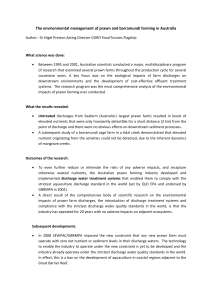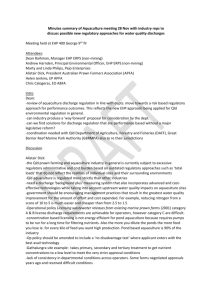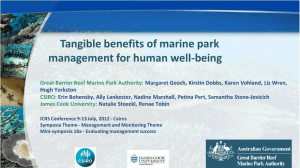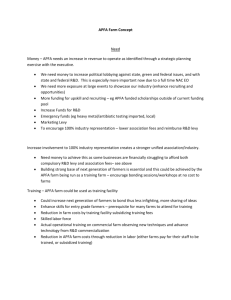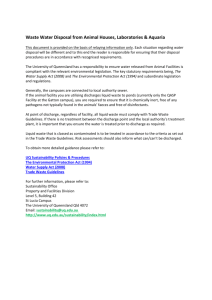ASIC 14-099MR Red Tape Reduction feedback
advertisement
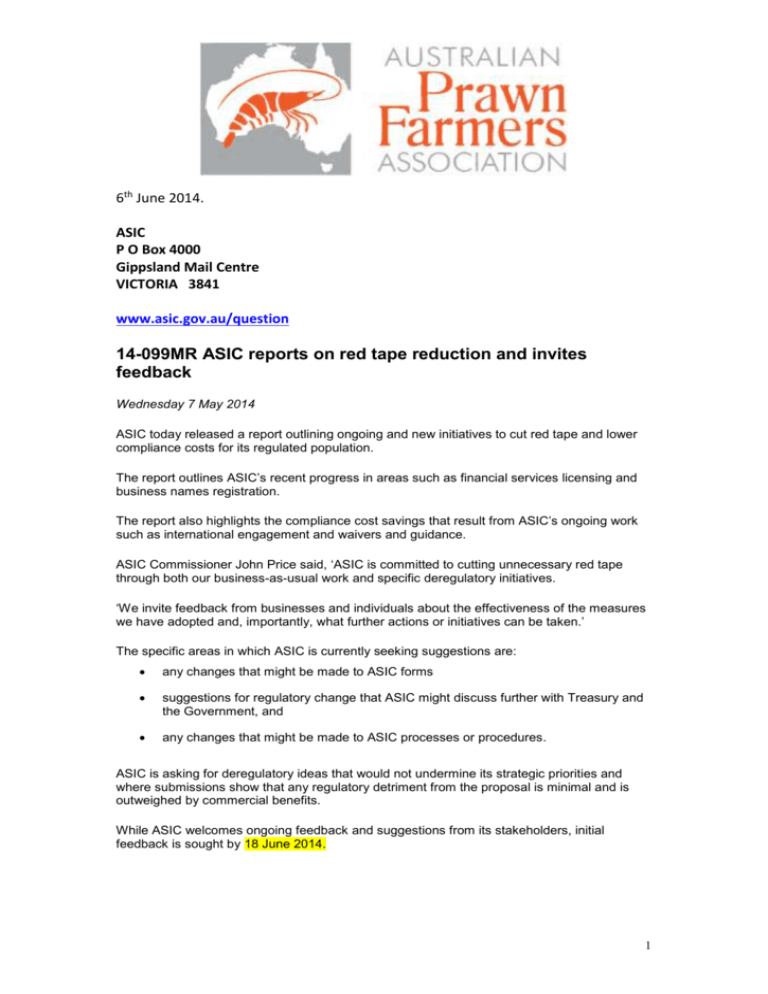
6th June 2014. ASIC P O Box 4000 Gippsland Mail Centre VICTORIA 3841 www.asic.gov.au/question 14-099MR ASIC reports on red tape reduction and invites feedback Wednesday 7 May 2014 ASIC today released a report outlining ongoing and new initiatives to cut red tape and lower compliance costs for its regulated population. The report outlines ASIC’s recent progress in areas such as financial services licensing and business names registration. The report also highlights the compliance cost savings that result from ASIC’s ongoing work such as international engagement and waivers and guidance. ASIC Commissioner John Price said, ‘ASIC is committed to cutting unnecessary red tape through both our business-as-usual work and specific deregulatory initiatives. ‘We invite feedback from businesses and individuals about the effectiveness of the measures we have adopted and, importantly, what further actions or initiatives can be taken.’ The specific areas in which ASIC is currently seeking suggestions are: any changes that might be made to ASIC forms suggestions for regulatory change that ASIC might discuss further with Treasury and the Government, and any changes that might be made to ASIC processes or procedures. ASIC is asking for deregulatory ideas that would not undermine its strategic priorities and where submissions show that any regulatory detriment from the proposal is minimal and is outweighed by commercial benefits. While ASIC welcomes ongoing feedback and suggestions from its stakeholders, initial feedback is sought by 18 June 2014. 1 PREFACE The Australian Prawn Farmers Association (APFA) welcomes this opportunity to highlight a prolonged regulatory impasse which has curtailed expansion plans for the majority of our membership for well over a decade. AFPA contends we have been singled out and subjected to burdensome and unnecessary regulation which prohibits the majority of APFA members from running their businesses in the way they need to. Our submission details how restrictions have been imposed despite contrary scientific studies and advice from an eminent and world renowned CSIRO scientist and others equally well respected. Our industry has to meet licensing and regulatory conditions set by local, state and federal governments. Our farmers do so willingly. The regulatory controls and standards set for us to adhere to are regarded as the most stringent imposed on an aquaculture industry anywhere in the world. Despite our strict adherence to environmental regulations, the imposition of a new regulation requiring any new prawn farms to operate with a zero net nutrient or sediment discharge in their discharge waters has hamstrung the prospect of prawn farming expansion in the north and far north of Queensland. Having readily met all regulatory controls since the industry's inception this impossible demand - six years ago - has left us reeling. This to an industry which has delivered and promises so much for Australia in future. A prime example - an increase in production would substantially lessen the need for imported prawn product which in current tonnage volumes is way and above what is produced domestically in our member’s farms. Our detailed submission recommends a considered, balanced and new regulatory approach to end this regulatory impasse. APFA considers the Great Barrier Reef Marine Park Authority should embrace a review of its decision making treatment of aquaculture development and if not the Authority should be compelled to agree to such a review. Stonewalling by GBRMPA would in APFAs opinion indicate the shortcomings with GBRMPA's obdurant - take it or leave it stance - to our industry would be exposed. 2 The Association notes ASIC is seeking submissions in three specific areas. The Association is encouraged and takes special comfort from Reference 2: "Suggestions for regulatory change that ASIC might discuss further with Treasury and the Government" could, we hope- if followed through by ASIC on APFA's behalf should help us to finally move forward into an expansionary phase, one still subject to the most rigid of regulatory controls. I commend the background and detail which follows in the hope you can realise the absurdity of the current circumstances APFA finds itself in and will recommend a way forward for us. SUBMISSION The Australian Prawn Farmers Association (APFA) welcomes the ASIC call for feedback on red tape reduction. The Australian Prawn Farmers Association (APFA) has grave concerns about the way GBRMPA administers it's management of the impacts of agricultural runoff specifically in regard to our farm operations. We consider we have been unfairly singled out and have been subjected to industry specific regulations which have been forced on us despite the best and most rigid of scientific studies - all made available to GBRMPA but brushed aside when we have endeavoured to negotiate a way out of our costly predicament. If the exhaustive studies by CSIRO's eminent Flagship Director (Acting) Food Futures National Research Flagship | Marine and Atmospheric Research, Dr Nigel Preston can be treated in such a cavalier fashion it certainly casts great doubt over "the adequacy, timeliness and transparency of independent work, to support government decisions impacting the reef." Please see Appendix A. Despite the prodigious volume of scientific studies supporting our case for expansion we are exasperated by GBRMPA's iron fisted, unyielding approach. There has been little "genuine, open and transparent consultation with our affected industry and relevant scientific experts" whenever we have tried to advance our case. Recent approval of a capital dredging project and offsets involved make a mockery of GBRMPA's demand of emulations that apply to our industry. Eyebrow raining contributions of millions of dollars to the Great Barrier Reef through the Reef Trust by the Abbott Point project is a glaring example. 3 GBRMPA,s approach to our industry over the last decade has simply been a case of "take it or leave it" whenever we have called for a rethink of federal regulations regarding future expansion of our industry. One that has been forced to mark time in the face of GBRMPA's intransigence. While more detailed explanation on the above follow we would welcome the chance for a representative or representatives to appear before your committee. We would also urge your committee to consider an on-site visit to one of the many prawn farms in the north and far north of Queensland to see firsthand the extensive and expensive remediation measures that are now a prominent feature of our farm operations. On behalf of APFA I ask that the committee consider that we are expert at what we do and have always produced top quality, environmentally friendly farmed product. We sell all we can produce, and will continue to do so if the industry is allowed to expand from $70 million to $412 million as we had planned for. An expansion of our industry could result in 2000 direct jobs being created. Queensland's Aquaculture Industry - of which prawn farming is the biggest sector has been constrained to just a mere 700 hectares of production. It is the only primary industry requiring water quality discharge measurements because we have point source discharge and we must meet the strictest water discharge standards in the world. From its inception - despite our small size - our industry has been subjected to many more comprehensive, scientific studies into its environmental impacts - 42 at last count - than any other primary industry in Queensland. Our discharges have had NO and this must be stressed NO adverse impacts on the receiving waters. We consider our operations are unique in this regard. Our confident assertion is fully backed by Dr Nigel Preston whose studies were referred to earlier in this submission. To ensure and ELIMINATE ANY RISK of adverse environmental effects of the Great Barrier Reef and recapture any wasted nutrients - the industry in conjunction with scientists have designed and implemented pond discharge treatment systems - 4 which comply with the strictest aquaculture discharge standard anywhere in the world. In fact the standard was established by Queensland's Environmental Heritage Protection Agency (EHP) and endorsed by GBRMPA. Farms already invest millions of dollars a year in environmental practices by locking up valuable production land as settlement ponds (e.g. A Mackay farm devotes 20 ha of settlement system out of 53 ha in total to achieve current best practice - this equates to lost production value of $3,000,000 per year. To our horrors and utter dismay - six years ago - SEWPAC and GBRMPA imposed a new constraint - insisting A NEW PRAWN FARM must operate with zero net nutrient or sediment levels in their discharge waters. This has effectively curtailed development of pond based aquaculture in coastal regions adjacent to the Great Barrier Reef. APFA believe that the precautionary principle has been misused with regard to aquaculture development in Queensland. It may have been an appropriate tool when the industry was first developed but 30 years after development there have been no adverse environment affects and over those years research has been carried out that supports industry development. Farms themselves are continually adopting best practice, adopting relevant research and implementing cutting edge technology that has enabled them to farm sustainably and profitably. There has been significant R&D effort over the last 15 years to fill knowledge gaps. APFA strongly believe this and the environmental record of the industry means the precautionary principle is not justifiable. Between 1995 and 2001, Australian scientists conducted a major, multidisciplinary program of research that examined several prawn farms throughout the production cycle for several successive years. A key focus was on the ecological impacts of farm discharges on downstream environments and the development of cost-effective effluent treatment systems. The research program produced 46 peer reviewed research papers on prawn pond nutrients and was the most comprehensive analysis of the environmental impacts of prawn farming ever conducted. 5 Overuse of the precautionary principle for prawn farm development and approvals has been incorrectly applied in all cases since 2001 especially where GBRMPA is involved. A proposal known as Guthalungra and used in many instances as a test case, is a prime example. The anticompetitive and discriminatory way in which GBRMPA apply the principles of the EPBC Act and the Precautionary Principles is evident in what GBRMPA allow with other developments. There is a large cane farm development that has recently been approved by the Burdekin Shire Council which is only 40-50km from the Guthalungra development and will have discharges into the same receiving environment. The property is “Glenyarra” station at Inkerman, owned by Rushel Produce. It is a 3000ha property that has been approved for 600ha of ‘intensive agriculture’. The reference number is Cons 13/0012 on the Burdekin Shire Council website. APFA notes that a new Federal Act is being prepared that, if passed, will protect the Federal govt if the EPBC Act is breached as a result of approvals of environmentally contentious developments such as mining or port developments. http://theconversation.com/australias-environment-minister-could-soon-be-abovethe-law23361?utm_medium=email&utm_campaign=Latest+from+The+Conversation+for+27 +February+2014&utm_content=Latest+from+The+Conversation+for+27+February+2 014+CID_c408a42058dd9079144a098707f56a2a&utm_source=campaign_monitor& utm_term=Australias%20environment%20minister%20could%20soon%20be%20abo ve%20the%20law GBRMPA Chair has been able to justify the Abbott Point dredging… http://theconversation.com/lets-dump-great-barrier-reef-dredging-myths-authoritychief-22991 Aquaculture is being deliberately targeted in an anticompetitive manner and held to ransom while others who cause damage to the Great Barrier Reef are allowed to grow and develop and continue to release unknown quantities of nutrients and pesticides onto the reef without any of the rigorous testing that is applied to prawn farming. 6 The cumulative effects of our expansion being curtailed - on jobs both full time and seasonal are very evident. A boost to support industries and to regional communities in the central and north of the state denied. Lack of prospective job opportunities has seen a number of aquaculture courses being dropped at university and tertiary levels. Ominously investors have shied away. Warnings of such an outcome signalled clearly in a 2006 Productivity Commission review and were again illuminated in a published research paper, by the Commission in the following year. Source: "Precaution and the Precautionary Principle: two Australian case studies by Weier, A and Loke, P released 18th September 2007. (1) In the body of the report much is made of the lack of scientific certainty being no barrier to regulators adopting precautionary principles. However in stark contrast we contend we have provided "full scientific certainty" to GBRMPA stemming from a multitude of environmental impact studies and most importantly the isotopic study, results and clear cut assurance of "no environmental harm" from Dr Preston's CSIRO study referred to in this submission. Most telling and of grave concern to APFA is the warning elaborated by researchers Weier, A and Loke, P in the following statement contained in Box 1.2 in their paper. Headed "Decision making distortion under prescriptive and semi-prescriptive definitions of the Precautionary Principle" paragraph 2: - 'Stifling development and technological innovation' encapsulates our objections to GBRMPA's approach to our industry. It reads: “Excessive application of precaution may stifle technological innovation and paralyse development. The impact of prescriptive versions will depend on how precautions implemented, and most importantly, what standard of proof of safety is required. Requiring zero (or close to zero) risk 'can be relied on to block action indefinitely, with all the associated costs' ( Cooney 2004, p. 36) while a less stringent standard of proof, such as "reasonable proof of safety" will be less restrictive of development and innovation. We submit that any dispassionate observer would have accepted Preston's study as "reasonable proof of safety". Hence our repeated assertion that GBRMPA has adopted an unyielding, dismissive and obdurant approach to our industry's expansion. 7 APFA regards environmental offsets as just another punitive and expensive regulatory burden which could - depending on the dollars required for such remedial work - very we'll stop any expansion or development by our farmers. State Government's own Reef Quality Water Protection plan baseline date from 2009 revealed 16,800,000 of total suspended solids were released - our industry accounted for only 1,314 tonnes (0.008%) of that. See table below. (2) Region Cape York Wet Tropics Burdekin Mackay Whitsunday Fitzroy Burnett Mary Totals Suspended solids per annum/tonnes 2,000,000 1,400,000 4,700,000 1,500,000 Total nitrogen tonnes 14,000 16,000 14,000 8,100 Dissolved Nitrogen tonnes 5,500 11,000 5,700 3,300 Total Phosphorus tonnes 1,500 2,000 2,600 2,200 Dissolved Phosphorus load tonnes PSII pesticides/kg 530 430 370 10,000 4,900 10,000 4,100,000 3,100,000 15,000 13,000 2,700 2,800 4,100 3,100 245 350 2,300 990 16,800,000 80,100 31,000 15,500 1,925 28,190 APFA data from a 2002 CRC study (3) Suspended solids (TSS) per annum/tonnes Total nitrogen tonnes 1,314 53 Dissolved Nitrogen tonnes Total Phosphorus tonnes Dissolved Phosphorus load tonnes PSII pesticides/kg Suspended solids per annum/tonnes 6.5 To put that into perspective for your committee - if our 1,314 tonnes of TSS was five inches high, the 16,800,000 would represent the height of Queensland's highest mountain - Mount Bartle Frere. The study showed an even greater comparison for nitrogen. Just 53 tonnes (0.066%) verses 80,100 all up. As for pesticides - an alarming, stark result - we discharge no pesticides compared to over 28,000 tonnes for other rural industries. We cannot stress enough how important from APFA's point of view that any review should be done with a "new set of eyes." For far too long APFA have been held back in an anti-competitive manner and have not been allowed to develop and prosper in the same way as other sectors who operate in the same GBR regions. Whether these sectors be agriculture, mining or 8 urban development they have been able to operate and prosper with conditions and approvals that have not been offered to aquaculture development. As an industry we are clearly and demonstrably focused on continual improvement to manage our discharge waters and to reduce any localised harm to the environment. In order to address our current impasse with GBRMPA we would like to see Queensland DAFF/EHP as the single environmental regulator for Queensland aquaculture. This would require endorsement of the federal government including GBRMPA. APFA urges that any developed regulation be based on a twostep monitoring system: 1. Set limits at the farm outlet for factors that may have a localised impact, for example oxygen and ammonia. 2. Monitor at the boundary of the mixing zone/Marine Park for any nutrients that are not assimilated within the estuarine system. Any offset system should be based on the residual nutrients (even though we are confident none will be detected) at this point. In addition industry development should occur in line with precise BMP’s (Best Management Practices) to provide assurance and comfort to all stakeholders. The Association considers such a system and regulatory approach would be reflective of the science and historical evidence provided by Dr Preston from CSIRO (see attachment to this submission. We cannot stress enough how important from APFA's point of view that any review should be done with a "new set of eyes." We urge a push be made for new people to assess and work with us to develop and outcome - inclusive of new people in GBRMPA. We would also like to see high level scrutiny be applied to this process to ensure it is developed with industry expansion in mind. We would welcome and support an independent peer review of the science at hand. APFA have for many years been seeking change and after more than ten years the bitter and protracted impasse imposed on prawn farm developments continues. We have implored other submissions to conduct a review into the decision making 9 processes of GBRMPA. If GBRMPA were not to embrace a review we would urge ASIC be compelled to hold one and for GBRMPA to be bound by its findings. We would regard any reluctance on GRBMPAs part to agree to an independent peer review into its anti competitive behaviour and decision making processes to be a clear indication of the shortcomings in its obdurant approach to our industry would be exposed. I commend this submission to you. Helen Jenkins. Executive Officer 10 Appendix A This paper content below was verbally delivered to a Queensland Government Cabinet Select Committee enquiry on March 19, 2014 by Dr Nigel Preston. The environmental management of prawn and barramundi farming in Australia Author: Dr Nigel Preston Acting Director CSIRO Food Futures Flagship What science was done: Between 1995 and 2001, Australian scientists conducted a major, multidisciplinary program of research that examined several prawn farms throughout the production cycle for several successive years. A key focus was on the ecological impacts of farm discharges on downstream environments and the development of cost-effective effluent treatment systems. The research program was the most comprehensive analysis of the environmental impacts of prawn farming ever conducted. What the results revealed: Untreated discharges from Seafarm (Australia’s largest prawn farm) resulted in levels of elevated nutrients that were only transiently detectible for a short distance (2 km) from the point of discharge and there were no obvious effects on downstream sediment processes. A subsequent study of a barramundi cage farm in a tidal creek demonstrated that elevated nutrient originating from the activities could not be detected, due to the inherent dynamics of mangrove creeks. Outcomes of the research: To even further reduce or eliminate the risks of any adverse impacts, and recapture otherwise wasted nutrients, the Australian prawn farming industry developed and implemented discharge water treatment systems that enabled them to comply with the strictest aquaculture discharge standard in the world (set by QLD EPA and endorsed by GBRMPA in 2002). A direct result of the comprehensive body of scientific research on the environmental impacts of prawn farm discharges, the introduction of discharge treatment systems and compliance with the strictest discharge water quality standards in the world, is that the industry has operated for 20 years with no adverse impacts on adjacent ecosystems. Subsequent developments: In 2008 SEWPAC/GBRMPA imposed the new constraint that any new prawn farm must operate with zero net nutrient or sediment levels in their discharge 11 waters. The technology to enable the industry to operate under the new constraint is yet to be developed and the industry already operates under the strictest discharge water quality standards in the world. In effect, this is a ban on the development of aquaculture in coastal regions adjacent to the Great Barrier Reef. Potential options to enable environmentally, economically and socially sustainable development of aquaculture adjacent to the Great Barrier Reef lagoon: A potential solution to moving beyond the current aquaculture development impasse with SEWPAC/GBRMPA would be to develop a spatial planning framework that includes; environmental and social values, species, production systems, market demand and surrounding uses of on-shore, nearshore and offshore regions. The approach has already enabled the Gold Coast City Council to achieve sustainable expansion of prawn farming in South East Queensland. This was achieved using the discharge water quality standards ratified in 2002. In this context, there is no scientific basis for imposing a constraint of zero net nutrient or suspended solids. The outputs from a spatial planning framework would provide a rigorous basis for establishing aquaculture zones along the Queensland coast. Tasmania and South Australia have already successfully developed and implemented science based aquaculture zones and the associated policies. If Queensland were to adopt a similar approach, in collaboration with all stakeholders, this could remove the most critical obstacle to environmentally, socially and economically sustainable development of aquaculture in Queensland, including coastal areas adjacent to the GBR, while ensuring that there continues to be no adverse impacts to the ecosystem health of the GBR. Note Peer-reviewed reference to the body of research cited above can be supplied References: (1) (2) (3) http://www.pc.gov.au/research/staff-working/precautionaryprinciple http://www.reefplan.qld.gov.au/measuring-success/report-cards.aspx http://www.pc.gov.au/__data/assets/pdf_file/0003/17607/sub045.pdf 12
